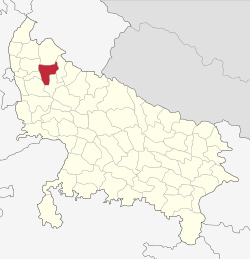Amroha district
| Amroha district अमरोहा ज़िला ضلع امروہہ | |
|---|---|
| District of Uttar Pradesh | |
 Location of Amroha district in Uttar Pradesh | |
| Country | India |
| State | Uttar Pradesh |
| Administrative division | Moradabad |
| Headquarters | Amroha Town |
| Government | |
| • Lok Sabha constituencies | Amroha |
| Area | |
| • Total | 2,321 km2 (896 sq mi) |
| Population (2001) | |
| • Total | 1,499,193 |
| • Density | 650/km2 (1,700/sq mi) |
| • Urban | 56% |
| Demographics | |
| • Literacy | 50.21 per cent[1] |
| Average annual precipitation | 42% mm |
| Website | Official website |
Amroha District, previously known as Jyotiba Phule Nagar, is one of the 75 districts of Uttar Pradesh state in northern India.[2] Amroha town is the district headquarters. According to Government of India, the district is one of the Minority Concentrated District in India on the basis of the 2001 census data on population, socio-economic indicators and basic amenities indicators.[3]
The district is bounded on the north by Bijnor District, on the east and southeast by Moradabad District, on the south by Badaun District, and on the west by the River Ganges, across which lie Bulandshahr, Ghaziabad, and Meerut districts.Having state highway 72 and 73 penetrating the city and act as a major route.
History
The Battle of Amroha was fought between Mongols and Alauddin Khilji on 20 December 1305. Alauddin won the Battle. Laterly the territory occupied by the present district was part of Sambhal sarkar of Delhi subah under Mughal empire. Later it came under the control of Awadh. In 1801, the administration of this territory was ceded to the British East India Company by the Nawab of Awadh. Last ruling Nawab Sheikh Anwar ul Haq . On 24 April 1997, this district was carved out by separating Amroha, Dhanora and Hasanpur tehsils of the erstwhile Moradabad district. In 2012, this district was renamed from Jyotiba Phule Nagar district to Amroha district.[2]
Demographics
According to the 2011 census 'Amroha District' has a population of 1,838,771,[5] roughly equal to the nation of Kosovo[6] or the US state of Nebraska.[7] This gives it a ranking of 258th in India (out of a total of 640).[5] The district has a population density of 818 inhabitants per square kilometre (2,120/sq mi) .[5] Its population growth rate over the decade 2001-2011 was 22.66%.[5] Amroha has a sex ratio of 907 females for every 1,000 males,[5] and a literacy rate of 65.7%.[5]
Media
Amroha has some active media groups which are continuously giving us Hindi News updates on Amroha. Media Groups - Amar Ujala,[8] Dainik Bhaskar, Dainik Jagran
References
- ↑ "District-specific Literates and Literacy Rates, 2001". Registrar General, India, Ministry of Home Affairs. Retrieved 2010-10-10.
- 1 2 "Important Cabinet Decisions". Lucknow: Information and Public Relations Department. Retrieved 17 January 2013.
- ↑ "Press Information Bureau English Releases". Pib.nic.in. Retrieved 2012-06-13.
- ↑ "Amroha Religion Census 2011". Office of the Registrar General and Census Commissioner, India. Retrieved 2015-11-16.
- 1 2 3 4 5 6 "District Census 2011". Census2011.co.in. 2011. Retrieved 2011-09-30.
- ↑ US Directorate of Intelligence. "Country Comparison:Population". Retrieved 2011-10-01.
Kosovo 1,825,632 July 2011 est.
- ↑ "2010 Resident Population Data". U. S. Census Bureau. Archived from the original on 2013-10-19. Retrieved 2011-09-30.
Nebraska 1,826,341
- ↑ "Hindi Newspapers". Amar Ujala. Retrieved 13 July 2016.
External links
- Official website
- Template:Road Distance Between Delhi and Amroha
 |
Meerut district | Bijnor district |  | |
| Ghaziabad district | |
Moradabad district | ||
| ||||
| | ||||
| Bulandshahr district | Budaun district |
Coordinates: 28°54′00″N 78°28′12″E / 28.90000°N 78.47000°E
Rickard, J (7 April 2010), Battle of Amroha, 20 December 1305, historyofwar.org